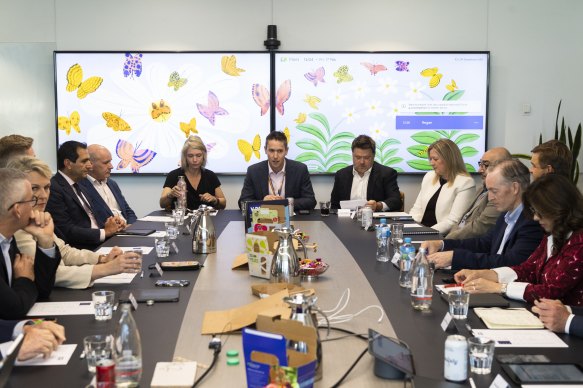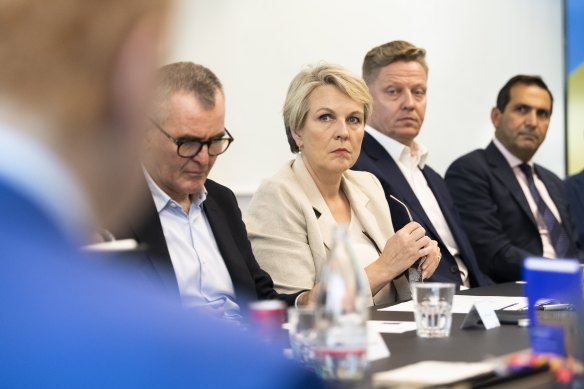This was published 1 year ago
Consumers driving environmental change, industry leaders told
By Laura Chung
How do you solve Australia’s recycling crisis? How do you minimise food waste? Can you reduce methane emissions? Can you make pet food packaging more sustainable? How do you better educate people on recycling? It’s just a number of questions that the business industry is grappling with.
At the roundtable on Friday, hosted by Nine newspapers and Visy Industries, senior executives of the major supermarkets and package food producers met to discuss how to increase the proportion of waste diverted from landfill for reuse and recycling. Environment Minister Tanya Plibersek said the government was prepared to regulate the plastics-recycling industry if voluntary codes failed to fix the crisis.

Key figures meeting in Sydney for an environment roundtable hosted by Nine newspapers.Credit: Rhett Wyman
“We need better systems if we want to have a truly circular economy, we need laws and better systems and institutions,” she said. “And it is worth doing it.
“Any successful policy in this area will need to build on your experience and work closely with your operations,” Plibersek told industry leaders.
Australia produces about 76 million tonnes of waste each year, of which over a quarter ends up in landfill, where it can leach toxins into the environment and greenhouse gasses into the atmosphere.
Tom Daunt, the chief executive of supermarket giant ALDI, said society was demanding more from the company, with consumers driving the majority of change. In 2022, the company set a goal of zero food waste to landfill by 2025. Daunt said the company was getting close, achieving 80 per cent last year, but he was nervous about the final push as it was the most difficult.

Environment Minister Tanya Plibersek at the conference.Credit: Rhett Wyman
The collapse of REDcycle last year highlighted how fragile the industry is. The Herald revealed soft plastics dropped off for recycling at supermarkets had been stockpiled since 2018 after REDcycle lost the capacity to recycle the product, but had failed to inform the public. The program was suspended in November and since then, the company has been ordered to bury millions of tonnes of waste in landfill.
Companies are now figuring out how to make packaging more sustainable. For the world’s biggest food and beverage maker, Nestle, that journey involves fully recycled packaging for KitKat wrappers or sustainable Nespresso coffee pods. Nestle chief executive officer Sandra Martinez said one of the biggest challenges was setting standards for waste collection, separation and management across the country
“We can help to educate, not only the government,” she said. “What is really required, not only from the food industry, is [harmonisation from] retailers, we need markets on board, we need whole players in this value chain really committed to making it work. We will make mistakes, but we need to learn because the train is getting out.”
Plibersek told industry leaders, including executive chairman of Visy Industries, Anthony Pratt, that the government was keen to work with industry and other levels of government to reach ambitious recycling targets, but if they were not met, the government would step in and regulate to force change.
Rather than rising to reach a target of 70 per cent by 2025, recycling rates have been stuck around 16 per cent for the past four years. Plibersek added the government will work on those steps with the industry, but is prepared to regulate if they do not work.
She added the federal government can help other levels of government “harmonise” the collection of waste across jurisdictions, particularly in co-ordinating container deposit schemes and kerbside waste collection. Plibersek added the government would also crack down on greenwashing.
Arnott’s chief executive officer George Zoghbi suggested that simplification of the kerbside waste collection was needed. This could include colour-coding packaging with a red, green or yellow dot to represent the bin it needed to be disposed of in.
The Sydney Morning Herald, The Age and Visy hosted the Recycling Roundtable on Friday, featuring key industry leaders and the Minister for the Environment, Tanya Plibersek.
Get to the heart of what’s happening with climate change and the environment. Our fortnightly Environment newsletter brings you the news, the issues and the solutions. Sign up here.